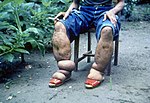 | Wolbachia is a genus of gram-negative bacteria that can either infect many species of arthropod as an intracellular parasite, or act as a mutualistic... 79 KB (8,387 words) - 00:12, 25 April 2024 |
 | Trichogramma (section Wolbachia in Trichogramma) parthenogenesis-inducing Wolbachia may be a difficult and rare phenomenon. However, when looking at the Wolbachia-host associations, the Trichogramma-Wolbachia form a monophyletic... 23 KB (2,550 words) - 00:55, 19 November 2023 |
 | of Wolbachia. Since Wolbachia is also maternally transmitted, it was found that the WNV-resistant phenotype is directly related to the Wolbachia infection... 48 KB (5,694 words) - 19:11, 5 April 2024 |
 | Phytoseiidae (section Wolbachia infections) Wolbachia species have been detected in many species of Phytoseiidae, both in the field and in the lab. Although most research focuses on Wolbachia in... 14 KB (1,571 words) - 11:58, 13 January 2024 |
 | Wolbachia pipientis is an intracellular bacterium that is an endosymbiont of D. immitis. All heartworms are thought to be infected with Wolbachia to... 41 KB (4,781 words) - 13:11, 8 April 2024 |
 | Mosquito control (section Wolbachia method) In the Wolbachia method, both male and female mosquitos that carry the Wolbachia bacterium are released into natural populations. Wolbachia boosts the... 56 KB (6,102 words) - 15:07, 8 March 2024 |
 | Aedes aegypti (section Infection with Wolbachia) population control. In 2016 research into the use of a bacterium called Wolbachia as a method of biocontrol was published showing that invasion of Ae. aegypti... 47 KB (4,971 words) - 20:57, 28 March 2024 |
 | Altica cirsicola (section Wolbachia infection) high Wolbachia infection rates are seen in Altica beetles. Cytoplasmic incompatibility is a form of mating incompatibility that is caused by Wolbachia infection... 27 KB (3,306 words) - 22:37, 24 April 2024 |
 | Nasonia vitripennis (section Wolbachia) homozygous or hemizygous. Wolbachia are maternally inherited, and exist in multiple insect species. Multiple strains of Wolbachia have been noted in even... 10 KB (1,278 words) - 08:38, 5 March 2024 |
 | endosymbiotic relationship with strains of the bacterium Wolbachia. In the absence of Wolbachia, larval development of O. volvulus is disrupted or ceased... 22 KB (2,411 words) - 17:50, 9 March 2024 |
many arthropod species that is caused by intracellular parasites such as Wolbachia. These bacteria reside in the cytoplasm of the host cells (hence the name... 26 KB (2,772 words) - 13:37, 2 March 2024 |
 | Brugia malayi (section Relationship with Wolbachia) survival and immune evasion. Since the discovery of the importance of Wolbachia bacteria in the life cycle of B. malayi and other nematodes, novel drug... 41 KB (4,649 words) - 07:07, 2 January 2024 |
 | which lays its eggs into ticks. It seems to use a symbiotic bacteria, Wolbachia pipientis, to weaken the tick's immune system. Ixodiphagus hookeri is... 6 KB (535 words) - 22:44, 30 December 2023 |
 | nematodes) live in symbiosis with Wolbachia, a type of intracellular parasite bacteria. In such cases the Wolbachia are necessary to the survival of the... 60 KB (5,018 words) - 04:30, 20 March 2024 |
Muscidifurax uniraptor (section Wolbachia symbiosis) the housefly Musca domestica and the stable fly Stomoxys calcitrans. Wolbachia is a cytoplasmically inherited intracellular bacterium. It can generally... 6 KB (741 words) - 08:37, 5 March 2024 |
 | complex interplay between several factors: the worm, the endosymbiotic Wolbachia bacteria within the worm, the host's immune response, and the numerous... 40 KB (4,379 words) - 18:51, 1 February 2024 |
reproductive cycle. Through laboratory methods naturally-occurring bacteria Wolbachia infect healthy male mosquitoes of the species Aedes aegypti. Subsequently... 1 KB (137 words) - 13:25, 27 February 2022 |
a Huck Scholar in Entomology. Her research investigates the bacterium Wolbachia as a strategy for biocontrol and to better understand the basis of its... 5 KB (558 words) - 03:17, 14 April 2024 |












